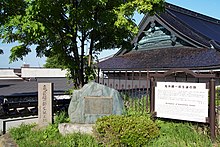Kamei Katsuichirō
Kamei Katsuichirō ( Japanese 亀 井 勝 一郎 ; born February 6, 1907 in Hakodate ; † November 14, 1966 ) was a Japanese writer and literary critic.
Life
Kamei studied literature at Tōkyō University . In 1927 he joined the Shinjin-kai ( 新人 会 ) and became enthusiastic about Marx and Lenin . He was imprisoned in Toyotama Prison ( 豊 多 摩 刑 務 所 , Toyotama keimusho ) from April 1928 to 1930 for suspicious violations of the Public Security Act . In 1934 he first published the magazine Genjitsu ( 現 実 ), a year later the magazine Nihon Romanha ( 日本 浪 曼 派 ), in which he published reviews.
In 1937 the education of man (gender) appears - an attempt on Goethe ( 人間 教育 (ゲ エ テ へ の 一 つ の 試 み) ), for which he received the Iketani Shinzaburō Prize a year later . In 1950 he was awarded the Yomiuri Literature Prize in the criticism / biographies category for Kyōnendo no shōsakuhin .
Kamei, together with Yasuda Yojūrō, is considered the most important representative of the Japanese romantic school.
Works
- 1937 Ningen kyōiku: Goethe e no hitotsu no kokoromi ( 人間 教育 ゲ ェ テ へ の 一 つ の 試 み )
- 1939 Shimazaki Tōson ( 島 崎 藤 村 )
- 1939 Sakka-ron ( 作家 論 )
- 1944 Nihonjin no shi ( 日本人 の 死 )
- 1946 Shōtoku Taishi ( 聖 徳 太子 )
- 1948 Kurata Hyakuzō hyōden ( 倉田 百 三 評 伝 )
Web links
Individual evidence
- ↑ Kato Shuichi: A history of Japanese literature . Kodansha 1979, Vol. 3, p. 236
| personal data | |
|---|---|
| SURNAME | Kamei Katsuichirō |
| ALTERNATIVE NAMES | 亀 井 勝 一郎 (Japanese) |
| BRIEF DESCRIPTION | Japanese writer |
| DATE OF BIRTH | February 6, 1907 |
| PLACE OF BIRTH | Hakodate |
| DATE OF DEATH | November 14, 1966 |

